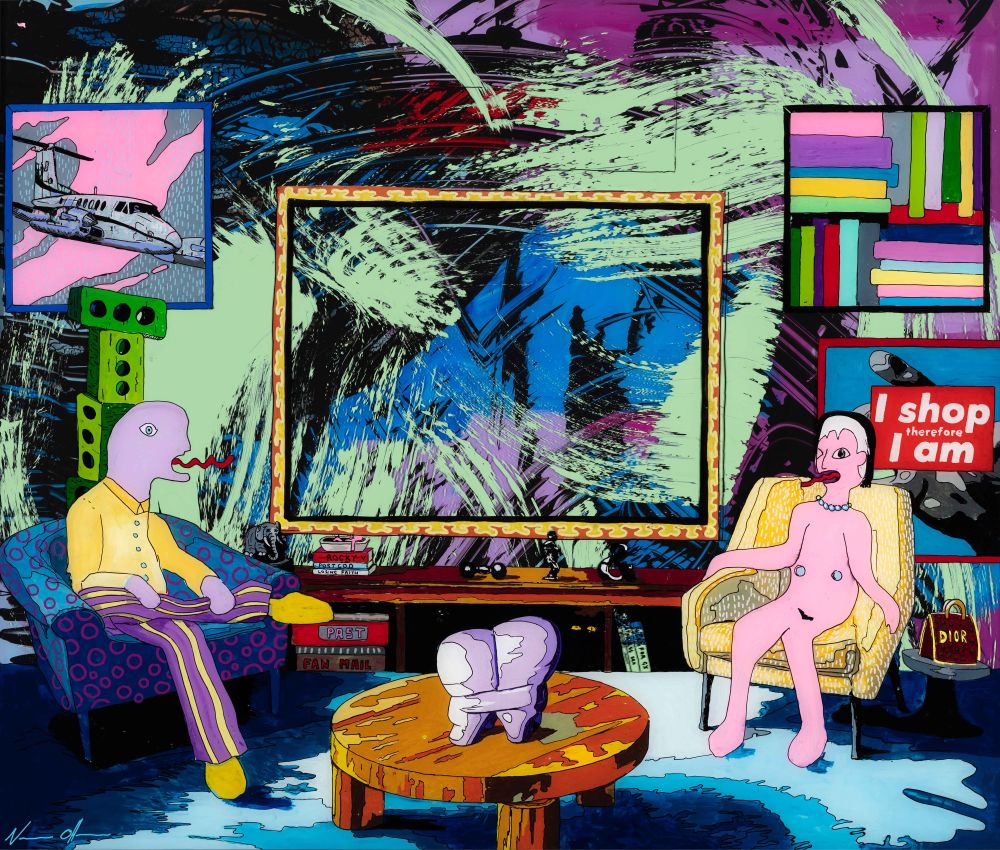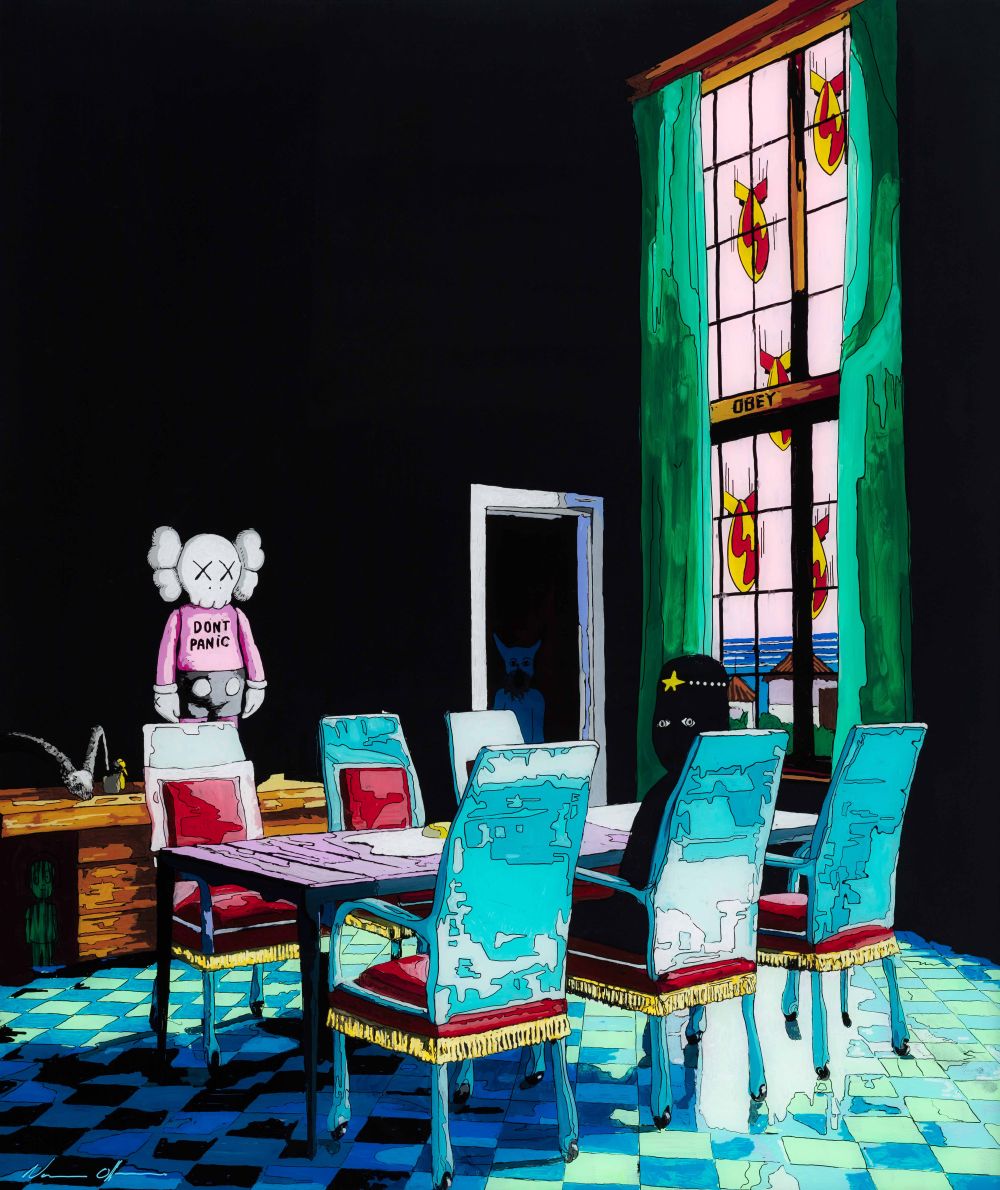Rules for Rebels and time warps for survival
WORLDART presents a solo exhibition by Norman O’Flynn
---------------------
 Norman O'Flynn, The Argument, R 36,522 ex. VAT, courtesy WORLDART
Norman O'Flynn, The Argument, R 36,522 ex. VAT, courtesy WORLDART
‘Eyes wide shut’, a small painting of disembodied eyes, is the work that significantly greets you as you step into ‘Rules for Rebels’. If the Timekeepers are the guardians to a New World Order, then these interiors are the waiting rooms. In a notable shift, O’Flynn’s work steps away from the representation of the humanoid / superhuman figure towards a spatial representation of our fragile universe.
O’Flynn uses ‘found interiors’ in this new body of work. By this, he refers to the fact that the ‘skeletal structure’ is sourced from design magazines and the ‘muscles and flesh’ added from various other sources. The paintings are time capsules that contain visual references to objects, events and news within contemporary life. Artworks by international blue chip artists such as Warhol, Basquiat, Keith Herring and Kaws are referenced alongside South African peers (‘Interior with Platter’, ‘Interior with Botes’ and ‘Interior with Maroon’). In most of the interiors, O’Flynn also playfully inserts representations of his own sculptures. References to popular films like “Fight Club” and “The Good, the Bad and the Ugly” are juxtaposed with actual and constructed book titles: ‘Faith in the Future’, ‘Positive Insults’, ‘Rules for rebels’. These phrases, like the tattoo slogans on the Timekeeper figures, suggest narratives that change depending on the sequence in which they are read; any story is always only a possible version of itself.

Norman O'Flynn, Queen of the Monarchy, R 36,522 ex. VAT, courtesy WORLDART
An avid reader and film lover, O’Flynn combines these references to create narratives in which the border between fact and fiction is usurped. The spaces are plush, but windows onto landscapes reveal the true state of affairs as things ‘outside’ fall apart. There is a constant interplay between comfort and disaster.
These paintings seem like incantations for change. In many of them, there are references to magic. In ‘Interior with Basquiat’ a small painting on the one shelf, includes the phrase: ‘Fuck normal, I want magic’. This seems like a good expression of Norman O’Flynn’s desire to transgress boundaries between the possible and impossible. Whilst making the painting O’Flynn was supposedly listening to podcasts on epigenetics. This, in O’Flynns words, “is a study of how your behaviour and environment can cause changes that affect how your genes work”.
In ‘Once Upon a Time’, dinosaurs - all herbivores - are grazing on the Swartberg mountains. These mountains re-appear in “View onto the Swartberg”, the only landscape painting in the series. These animals are the ancestors of the Ostrich that is now roaming the Karoo. O’Flynn has an affinity for stretching time and space in order to highlight how relative our perception of these are. In the middle ground ideas are floating in the lake referencing the subconscious, whilst the two mermaid sculptures inside guard the window. The rat on the armchair, is a nod to Banksy.
‘Interior with Platter’ foregrounds the wooden bricks of artist Cameron Platter as building blocks for life. These are placed next to Warhol’s ‘Marilyn’ against the background of mermaid scales, echoing those in “Once Upon a Time”. In the background a dark passage suggests the unknown and includes a small portrait of the artist’s son.
 Norman O'Flynn, Interior with Lichtenstein, R 36,522 ex. VAT, courtesy WORLDART
Norman O'Flynn, Interior with Lichtenstein, R 36,522 ex. VAT, courtesy WORLDART
Says O’Flynn, ‘What kind of work should we make post-Covid? We all hoped that the world was going to change its ways, but it was but a brief reprieve. We are back to the ‘natural order’ of chaos and destruction. In the end, it seems it is still mainly all about MONEY and POWER.’
‘The Argument’ is the only painting that contains figures. These figures however, are cartoons with wagging tongues, as if their sole aim is to make noise. The female figure is based on a sex doll/ female companion and represents social media and the internet whilst the male figure seems like an old academic. O’Flynn is not choosing sides, but documents the ongoing strife between old and new forms of knowledge. ‘The Death of Marat’ (1793) by Jacques-Louis David, features in a number of works. An interesting choice, as it is a symbol of the slain revolutionary.
What we are offered are small pockets of hope and the assurance that the only constant is change.
- Liza Grobler
Further Reading In Articles
African Artist Directory















